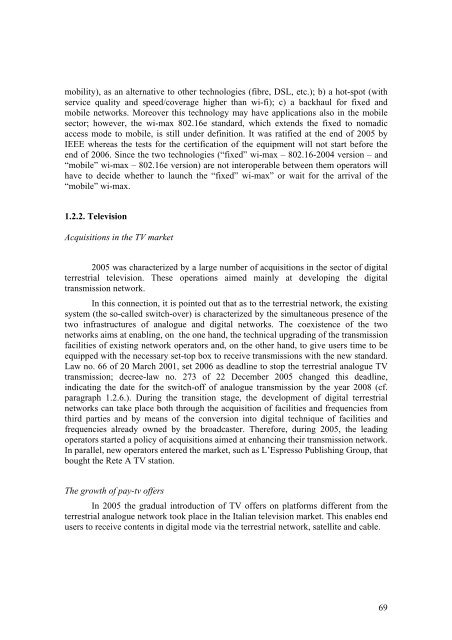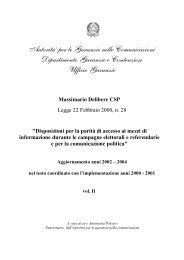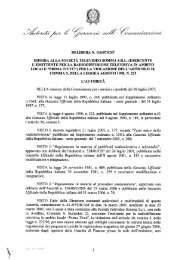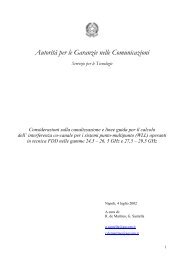Communications Regulatory Authority
Communications Regulatory Authority
Communications Regulatory Authority
Create successful ePaper yourself
Turn your PDF publications into a flip-book with our unique Google optimized e-Paper software.
mobility), as an alternative to other technologies (fibre, DSL, etc.); b) a hot-spot (with<br />
service quality and speed/coverage higher than wi-fi); c) a backhaul for fixed and<br />
mobile networks. Moreover this technology may have applications also in the mobile<br />
sector; however, the wi-max 802.16e standard, which extends the fixed to nomadic<br />
access mode to mobile, is still under definition. It was ratified at the end of 2005 by<br />
IEEE whereas the tests for the certification of the equipment will not start before the<br />
end of 2006. Since the two technologies (“fixed” wi-max – 802.16-2004 version – and<br />
“mobile” wi-max – 802.16e version) are not interoperable between them operators will<br />
have to decide whether to launch the “fixed” wi-max” or wait for the arrival of the<br />
“mobile” wi-max.<br />
1.2.2. Television<br />
Acquisitions in the TV market<br />
2005 was characterized by a large number of acquisitions in the sector of digital<br />
terrestrial television. These operations aimed mainly at developing the digital<br />
transmission network.<br />
In this connection, it is pointed out that as to the terrestrial network, the existing<br />
system (the so-called switch-over) is characterized by the simultaneous presence of the<br />
two infrastructures of analogue and digital networks. The coexistence of the two<br />
networks aims at enabling, on the one hand, the technical upgrading of the transmission<br />
facilities of existing network operators and, on the other hand, to give users time to be<br />
equipped with the necessary set-top box to receive transmissions with the new standard.<br />
Law no. 66 of 20 March 2001, set 2006 as deadline to stop the terrestrial analogue TV<br />
transmission; decree-law no. 273 of 22 December 2005 changed this deadline,<br />
indicating the date for the switch-off of analogue transmission by the year 2008 (cf.<br />
paragraph 1.2.6.). During the transition stage, the development of digital terrestrial<br />
networks can take place both through the acquisition of facilities and frequencies from<br />
third parties and by means of the conversion into digital technique of facilities and<br />
frequencies already owned by the broadcaster. Therefore, during 2005, the leading<br />
operators started a policy of acquisitions aimed at enhancing their transmission network.<br />
In parallel, new operators entered the market, such as L’Espresso Publishing Group, that<br />
bought the Rete A TV station.<br />
The growth of pay-tv offers<br />
In 2005 the gradual introduction of TV offers on platforms different from the<br />
terrestrial analogue network took place in the Italian television market. This enables end<br />
users to receive contents in digital mode via the terrestrial network, satellite and cable.<br />
69















